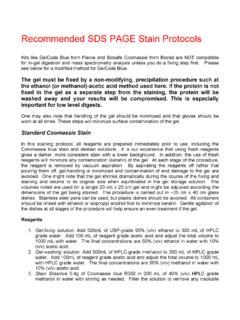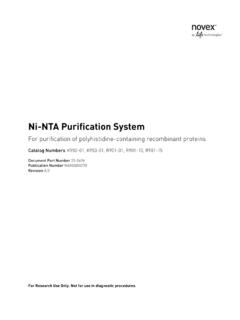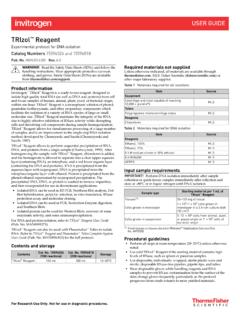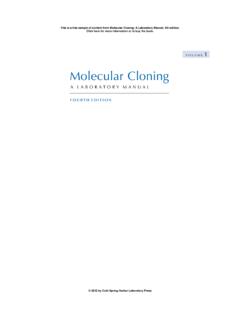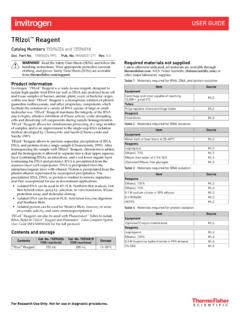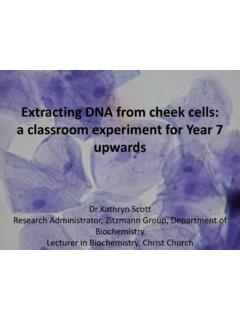Transcription of Miniprep Protocol - University of Florida
1 Miniprep Protocol Points of Emphasis: The entire Miniprep procedure takes 40-45 min. The video shows purification of cDNA from one bacterial culture. Normally, 9-18 cultures are processed at one time so the procedure will take longer, especially for beginners. Use proper pipetting techniques to insure that that 1000 l pipet does not become contaminated with bacterial culture. Be sure to label tubes carefully and do not mix up samples during this procedure ( the labels on the bacterial tubes and microtubes should match). Keep the bacterial culture tubes until we identify the correct clones (usually after restriction digest of the isolated cDNA). If the results of the digest are not completed after the isolation of the cDNA from the bacteria, store the bacterial cultures overnight in the refrigerator. 1. Inoculate 3ml LB medium (containing antibiotic) with a bacterial clone, culture with vigorous shaking at 37 degree for 14-16 hrs.
2 For carbenicillin (50mg/ml) or kanamycin (50mg/ml) add 3ul antibiotic to 3ml LB broth. Be sure to use the correct antibiotic for selection of the clone you are growing! 2. Aliquot 2 x 750 ul culture into a ml LABELED microcentrifuge tube, harvest the bacteria by spinning at 12000rpm (~11000g) for 1 min. Remove (aspirate) supernatant and keep pellet using vacuum apparatus fitted with a green pipet tip. If cell growth is low, you may add an additional 750 ul culture media to the pellet, respin, and aspirate supernatant. 3. Resuspend bacterial pellet by complete vortexing in 100ul Solution A resuspension buffer. Solution A (25mM Tris-HCl, , 10mM EDTA) is in the refrigerator under the research bench. To prepare the working solution A, add 3ul of RNAseA to 1 ml solution A and mix well. RNAseA is stored in a plastic cup above the lab bench area.
3 When preparing resuspension buffer, make enough for the number of minipreps you are processing plus 2 this will ensure that you have enough solution. The bacteria should be COMPLETELY resuspended - no clumps should be visible. 4. Add 100ul freshly prepared lysis buffer (50 ul 400mM NaOH, 50 ul 2% SDS) and mix gently by inverting 5-6 times at room temperature. To make lysis buffer mix equal volumes of 800mM NaOH and 4% SDS solutions and make enough for the number of preps you are processing plus 2. The Miniprep mixture should appear translucent and mucous-like after mixing. Do not allow the lysis to occur for longer than 5 minutes. 5. Add 120ul solution K (neutralization buffer) (5M potassium acetate, ) and mix gently by inverting 5-6 times. Incubate the solution at room temperature for 3 min. Solution K is kept in the refrigerator under the lab bench.
4 The mixture should contain flocculent white precipitate at this point that consists of bacterial DNA and protein. 6. Remove bacterial/protein debris by centrifugation at 12000rpm for 2 min. Transfer the supernatant to a fresh LABELED microcentrifuge tube. The precipitate is "sticky". To transfer use a 1 ml pipet tip, depress pipet plunger, move tip to bottom of tube and aspirate supernatant. Some of the protein floating on the surface will adhere to the outside of the pipet tip when you pass it through the solution. This is okay. When transferring the supernatant to the new tube, do not touch outside of pipet tip to new tube - avoid transfer of precipitate to the new tube. 7. Add 200ul isopropanol (2-Propanol) to precipitate plasmid DNA from supernatant. Mix thoroughly by inverting 10 times. It is also okay to vortex briefly. Incubate at room temperature for 1 min.
5 If you do not mix thoroughly, the DNA will not precipitate. 8. Collect DNA by centrifugation at 14000 rpm for 1 min. Immediately pour off isopropanol into beaker, shaking tube slightly after the pour to remove a bit of the excess isopropanol. If the tubes sit too long, the DNA will loosen from the side fo the tube and may be accidentally discarded. Don t worry about removing all of the isopropanol. The DNA pellet may be visible in the tube (depends on purity and amount of plasmid DNA). If you can not see it, it is okay. Be sure to orient the tubes in the centrifuge so that the cap hinge is toward the center of the rotor. That way, the DNA pellet will be located on the bottom away from the hinge so you can find it. 9. Add 500 ul 70% ethanol to tube, mix by inverting (brief vortexing okay too). Re-spin the DNA down at 14000 rpm (full speed) for 1 min.
6 10. Immediately pour off ethanol and place the tube back into the centrifuge with same orientation. Respin for 1 min. Use 100 ul pipet to carefully remove remaining ethanol. You can use the same tip to do this for all samples. Blot any excess ethanol in the tip using a Kimwipe tissue. Air-dry DNA for 10 min with caps open on the lab bench. 11. Dissolve DNA in 20-35 ul water, the volume used depending on whether you saw pellets or not. Be sure to use best water in the lab for this (de-ionized found in carboy by sink). If in doubt, refill 50 ml conical tube with fresh water from the carboy. Use 20-25 ul if you did not see any pellets on the sides of the tubes during the precipitation and wash steps above (steps 8-10). The final concentration of DNA should be g / l and the 260/280 value should be above


